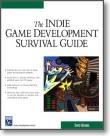
|
Author: David Michael
Pages: 384 Published: Charles River Media (August 14, 2003) ISBN: 1584502142 |
Introduction
The Indie Game Development Survival Guide is quite a rare find for game development books, in that it's aimed squarely at "indie" game developers. The book is divided into seven sections, and each of these is divided into several chapters. The back of the book also contains the results from a survey of indie developers, and findings from this survey are scattered throughout the various sections. Each chapter finishes with a brief conclusion, which nicely summarises what has been covered.
The Seven Major Sections
Indie Basics
The first section serves as a gentle introduction to the world of indie development. It explains what an indie developer is, why people decide to go indie and what being an indie entails.
Once this introduction is over, the section moves into more important issues, such as how to start business, choosing a business structure and some time management hints. The business structure information is not particularly in-depth, but it gives the fundamentals that are useful for making a decision.
Game Design for Small - or No-Budget Games
It's very easy to let your imagination run riot when thinking of game ideas, and this chapter helps explain some of the limitations that you'll face as an indie.
This section also covers the dreaded design document. Most design documents have to encourage a publisher to sign the game, so often contain information that is useless to the average indie. Thankfully, unlike other books and articles, this section is tailored towards the indie approach. Examples are given from the Paintball NET design document, which help if you've never seen a design document before.
Production Planning
Once you have a design for your game, it's time to move on to planning how you're going to create it. Setting tasks and milestones are a big part of project planning, and are discussed in this section. Examples from Paintball NET are used here, and are useful for seeing how a real project divides up its tasks.
Budget and risk management are also covered, which will help prevent you from receiving nasty surprises during your game's development.
The final chapter in this section covers "creative funding", which discusses several approaches to raising money for your fledgling project.
The Team
You don't have to work alone to be an indie, and the internet allows people to work together on a project without sharing an office. This section details the basics of having a team, as well as how to find and manage your team. It also discusses how to compensate your team, which is definitely worth looking at if you don't intend to work solo.
Building the Game
Once you've designed your game, planned how it's going to be created, and possibly roped in a few unsuspecting souls to help, it's time to build it!
There's a lot to cover in this section, and it touches on iterative development, resource management, documentation and testing. Hundreds of books cover this information in great detail, but these chapters can help point you in the right direction.
Selling the Game
And now for the bit where huge sacks of cash are delivered to your door, and everyone buys swimming pools and personal jets.
This section covers all the important aspects of selling your game, such as choosing a payment processor, setting a price and letting the world know about your wonderful product.
The Future (Evolution via Feedback)
The final section covers "Evolution via Feedback". Once your game is finished, there will still be improvements that can be made and features that can be added, and the last few chapters describe how to obtain feedback, and how to use it to improve your product.
The Good Bits
For starters, it's extremely refreshing to see a game development book that is written for indie developers.
The whole book covers just about everything that a start-up indie could want, whether it's the business side or the more technical side. Thankfully it steers clear of the more common areas, such as coding style tips and "How To Make A Pretty Gantt Chart". The information given is clear and relevant, and backed up with either survey results from real indies, or from the author's own experience working on Paintball NET and Artifact.
The Not So Good Bits
The problem with covering so much is that parts of the book are a little thin. This isn't a major problem as the fundamentals are often covered in enough detail, and information relating to software and the internet can quickly go out of date. After reading, you can't help but feel that maybe it tried to do a little too much.
It is advisable to research certain areas yourself, particularly the business side of things as it only covers the basics for the USA.
In Closing...
If you're new to this whole indie thing, I'd highly advise you give this book a chance. It's well written, informative and will help you get a good mental picture of (nearly) everything that's involved.